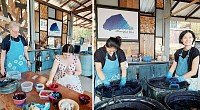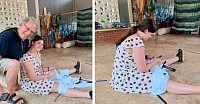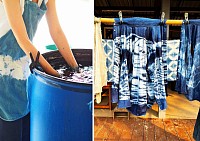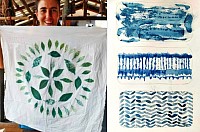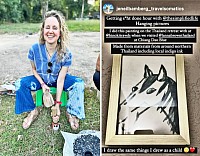Siripohn's Insights (Blog)
Nok Yung: An intern student at Chiangdao Blue Studio.
In her previous internship, Nok Yung practiced making paper stencils for use with Kata-Zome. During this school holiday, she will be learning the art of fabric patterning through shibori and Ita-jime techniques. Nok Yung is an ethnic Tai Yai girl whose parents migrated from northern Myanmar. Now 16 years old, she is in her grade 10 high school in Chiang Dao.
Nok Yung is a focused and determined young woman, gifted in craftsmanship. Her talent for intricate and detailed work is exceptional. She is welcome to take on part-time work at our studio. She is proud and excited to be able to earn money on her own and make personal purchases without relying on her parents' support.
Mindful Moments Through Hand-Drawn Expressions
Capture your meaningful moments through images in your own style, guided by your feelings. Whether it's a simple sketch with a few words or an illustration that brings back memories, expressing these moments and emotions with your hands is a special way of mindfulness. The drawing doesn't need to be perfect—what matters is that it's created by your hands and filled with your heartfelt emotions.
Sakiori: A Sustainable Weaving Craft That Everyone Can Enjoy
At Studio Chiangdao Blue, we practice a traditional Japanese weaving technique known as "Saki-ori." In this method, "Saki" refers to cutting fabric into long strips, about 1 cm wide, and "Ori" means weaving. The essence of Sakiori is to repurpose old or discarded clothing, whether they are worn out or stained, and transform them into something new. Instead of throwing them away, we cut the fabric into strips and use them as the weft for weaving on a compact hand loom that fits comfortably on a table—perfect for a relaxing hobby.
The width of the woven fabric in Sakiori typically doesn’t exceed 50 cm. The resulting cloth is thick with interesting textures, ideal for creating simple items like tote bags, cosmetic pouches, tapestries, or table runners. One of the unique aspects of Sakiori is that anyone can weave, regardless of experience. Simply choose the colors of the fabric strips, and weave them horizontally. It's a fun and easy way to mix and match colors, allowing anyone to create their own unique patterns. This activity promotes relaxation and mindfulness as you focus on the weaving in front of you. Once completed, you'll feel proud of your handmade creation, and develop a special bond with the fabric, cherishing it even more.
Sakiori offers a peaceful and fulfilling experience, inviting you to slow down and enjoy time with yourself. By participating, you may find yourself looking at the things around you differently—understanding the connection between yourself and the world, and discovering new ways to repurpose and appreciate what you already have.
Come and experience Sakiori, and you might just fall in love with it. It may even change the way you think about the items in your life!
Let’s use crafting to help the elderly feel a true sense of purpose every day!
Seven years ago, I moved my mother from the city of Chiang Mai to a small village in the rural district of Chiang Dao, Chiang Mai Province. My mother is now 90 years old and suffers from bone issues, making it difficult for her to walk without assistance. She requires 24-hour care. Despite her bone condition, my mother remains healthy as she has no issues with blood pressure or diabetes. She’s mentally sharp, energetic, and always needs to be engaged in something, as sitting idle makes her anxious and irritable. However, when she has something to focus on, she can immerse herself in an activity for two to three hours at a time.
Since I work with natural indigo dyeing, about 4 or 5 years ago, I started introducing her to tie-dyeing bandanas or Furoshiki (as they're known in Japanese), which are about 70x70 cm in size. These are used as packaging for the clothes our customers purchase, helping reduce plastic waste, and the fabric can be reused by the customers.
In the beginning, I taught her shibori techniques, which are basic methods of creating patterns in the Japanese style. My mother quickly found joy in this shibori tie-dyeing activity. What really excited her and brought her happiness was the magic moment of unwrapping the fabric after dyeing to reveal the pattern she had created. Her expressions, the smiles, and laughter during these moments were priceless. It was clear that this was a sense of fulfillment for her every time she worked with the fabric.
Over the 4 or 5 years that my mother has pursued shibori tie-dyeing as a hobby, she has continued to make one piece a day, and on some days, even two or three pieces, depending on her mood. One fascinating thing I’ve noticed is that once she understood how patterns are formed, she started creating new designs using her imagination. She figured out how to twist the fabric and adjust the rubber bands, either loosely or tightly, to achieve the patterns she envisioned.
From my experience of watching my mother engage in shibori tie-dyeing over these years, I’ve been deeply impressed by how this activity has helped her stay focused, prevented her from overthinking, and given her a strong sense of purpose, or ikigai, every day.
I wanted to share this experience as an option for children caring for elderly parents or grandchildren looking after their grandparents. Finding a simple craft that the elderly are interested in or have some skills in can allow them to enjoy the activity and, most importantly, feel a sense of meaning in their everyday lives.
Homegrown indigo paste
The image shows the delicate process of filtering indigo paste through fine cloth to capture the rich blue pigment. (This particular paste is extracted from the *Indigofera tinctoria* leaves.)
At our studio, we use this indigo paste to create an indigo dye pot by mixing it with alkaline water from limestone powder and tamarind water, which acts as a natural reducer. When the indigo paste, alkaline water, and tamarind water are combined at the right temperature, a chemical reaction called reduction occurs. This changes the solid, water-insoluble blue indigo into a soluble yellow liquid.
When fabric is dipped into this yellow dye bath and then exposed to air, the yellow hue reacts with oxygen, transforming back into its original solid blue form. The oxidized indigo becomes trapped within the fibers of the fabric, completing the dyeing process.
Indigo is known for its strong bond with natural cellulose fibers, which is why we still see indigo-dyed fabrics from over a thousand years ago, retaining their beautiful blue color even today. While indigo-dyed fabrics can be prone to wear and fading with frequent rubbing, there’s a unique charm to this natural indigo – even as it fades, it takes on a lovely vintage blue appearance that synthetic dyes simply can't replicate.
If you’re curious to try working with homegrown indigo paste and experience the magic of natural indigo dyeing, we warmly invite you to visit and create with us!
Painting with natural blue from plants
Natural blue pigments, aside from those derived from stones like lapis lazuli, also include the beautiful indigo, which is extracted from the leaves of the indigo plant. This is a fascinating source of blue from nature, as very few plants provide this rare color. The tradition of natural indigo dyeing is like a gift from the divine, shared with people across every continent, from Asia to Europe, Africa, and South America. Each region has its own unique methods of indigo dyeing, passed down through generations, using local materials to prepare indigo vats for dyeing fabrics.
Here at Studio Chiangdao Blue in Thailand, we grow four types of indigo plants: *Indigofera tinctoria*, *Indigofera suffruticosa*, *Strobilanthes cusia* (Assam indigo), and *Persicaria tinctoria* (Japanese indigo) to extract indigo from the leaves for use in our own dyeing projects. Our "from seed to dye" concept ensures that we create indigo paste with a high percentage of blue pigment, allowing us to control the quality of the indigo by filtering it through fine cloth to achieve a smooth texture. This high-quality paste is perfect for both dyeing fabrics and painting on paper or textiles.
For those who participate in our indigo dye workshops, if we know you're interested in painting, we love to invite you to try painting with our homegrown indigo paste on watercolor paper.
*The artwork shown was created by two sisters from Israel, who painted this beautiful and amazing piece together.*
If you’re interested in painting with indigo paste, we warmly welcome you to join us. We look forward to your visit!
Unearthing New Possibilities and Answers through Traditional Wisdom
From my experiences over the years working on various design and product development projects, I've collaborated with local artisans, design students, and professional designers from Thailand and Japan. Each year, my field trips to various villages, including those of local communities and hill tribes, have allowed me to immerse myself in the local crafts of diverse subcultures. These crafts utilize a wide range of natural materials—fibers, fabrics, paper, bamboo, ceramics, and more. Each trip leaves me in awe of the craftsmanship and creativity rooted in a life intertwined with natural materials. The simplicity yet practicality of these skills demonstrates a profound understanding of the materials' properties through direct experience, trial and error, and insightful problem-solving, traits I believe are innate in all humans.
Sometimes, the convenience of modern life, where everything is just a purchase away, may diminish these inherent capabilities in today's people.
Having the opportunity to reactivate these inherent abilities within us is both fascinating and challenging because these capabilities can connect with concepts of "meaning and value" in life.
Lately, we often hear about the Japanese concept of "Ikigai" and the quest to understand the "reason for being." While understanding from books is beneficial, comprehending "Ikigai" through engaging in small, passionate activities like gardening, cooking, arts, or crafts might enrich this understanding. Engaging directly in these activities allows us to experience the process with full sensory involvement—seeing, hearing, and using our hands alongside creative thinking. Often, we find joy and meaning in life during these moments.
By stepping out of our familiar environments to engage with new settings and experiences we've chosen, we may discover hidden potentials and answers to life's persistent questions—potentials that could provide profound insights into our existence.
Unleashing Creativity in Travel: A Journey of Memorable Experiences
My interest in Creative Tourism was sparked in part by reading the article "Introducing Creative Tourism: what is it & why is it valuable for community empowerment" by Viktoria Petrova. A quote from Confucius featured in the article struck me profoundly:
"I hear and I forget, I see and I remember, I do and I understand."
As an indigo farmer & natural dyer who moved from the bustling city of Chiang Mai to the rural serenity of Chiangdao District just 5-6 years ago, I vividly recall the excitement and challenges of adapting to a rural, agricultural lifestyle—a stark contrast to anything I'd experienced before. Everything felt refreshingly new and intriguing. The close proximity to nature, the sounds of wind, birds, and insects, and the daily sunrise and sunset routines awakened all five senses, making me more aware of my surroundings. This slower pace of life allowed me to see the interconnectedness of things and uncover potential and capabilities I hadn't noticed before.
Initially, when I set up the studio for indigo and natural dyeing, I hadn't planned on cultivating indigo plants. However, living here and getting hands-on experience broadened my understanding and revealed numerous possibilities. Daily life became meaningful and enjoyable, filled with activities I was eager to explore, inspired by the diverse natural resources around me. These natural materials ignited creativity and a desire to learn more, a process that seemed endless. It felt like every cell in my brain and body was dancing with excitement.
This contrasted sharply with my earlier city life, which, over the years, had become monotonous, dull, and sometimes lethargic.
The past 5-6 years in Chiangdao have been fun, challenging, but also incredibly peaceful. My understanding of "the meaning and value of life" has evolved, offering new perspectives.
In recent months, hosting natural indigo dyeing workshops has allowed me to meet people from around the globe, all seeking the unique experience offered by Studio Chiangdao Blue. These interactions have been enlightening, showcasing the joy, excitement, pride, and happiness people feel when creating something by hand, whether for personal use or as gifts for loved ones. These handmade gifts, crafted with love and creativity, undoubtedly hold a special place in the hearts of both the maker and the recipient.
I believe Creative Tourism addresses the need for deeply engaging, personalized travel experiences. It emphasizes small, intimate groups allowing for a special time to learn, acquire skills in local crafts, and closely connect with local people and environments.
"..... I see and I remember, I do and I understand."
Studio Chiangdao Blue is ready to create memorable creative traveling experiences with you through our private workshops "from seed to dye, natural indigo dye."
Let Girls Revel in Their Imagination and Their Indigo
Last Thursday, Studio Chiangdao Blue had a pleasure of welcoming a sweet grand father and his grand daughter from the USA. It’s always heartening to see our studio becoming a place where friends, lovers, children, designers, and families can spend quality time together, seek new experiences, learn, and let their creativity flow while having fun with handmade crafts and experiencing the allure of natural indigo.
It was another special day when the grand father and his high school-aged grand daughter spent their time crafting together in a private workshops. After introducing them to the indigo plant, its seeds, and the dyeing process, we began introducing them fabric pattern techniques. They chose to dye a bandana and a big scarf. The girl, though quiet, seemed very interested. With her first bandana, she creatively applied almost every shibori technique that we introduced onto that small piece of fabric. The outcome was beautifully balanced and exceptionally creative. After lunch, she began working on the big scarf, seemingly having a clear image of the fabric’s pattern and techniques she intended to use. It was evident in her second piece that she felt more confident and relaxed, naturally being herself and applying the techniques in her unique style with great focus. Her grand father mentioned she had enjoyed handmade crafts since childhood, making her own jewelry and sometimes even her clothes. I wasn’t surprised to see her so immersed in her world, deeply engaged in creating patterns on the fabric using various techniques to bring her imagination to life. And just as I thought, her work turned out to be uniquely hers, truly one-of-a-kind work piece. The grand father was visibly happy to arrange an activity that his grand daughter loved and enjoyed doing.
I was impressed by her concentration, creativity, and her ability to instantly and naturally apply the newly learned techniques to her work. It made me realize that every child or young person has their potential, interests, and aptitudes. If they discover these and are given the chance to earnestly practice, they can shine in ways we adults might not even imagine.
Thank you to the wonderful grand father and our talented young lady for coming to sparkle with their talents and creativity here in Chiangdao.
Let's Upcycle Our Beloved Pieces
Last Monday, Studio Chiangdao Blue invited our young friends passionate about eco-friendly concepts to dye old clothes that had faded or were stained—garments too cherished to be discarded just yet.
I encouraged them to select white or light-colored natural fiber clothes, such as cotton, linen, or rayon, that she still liked. We set out to create various designs as per our whims and dye them with natural indigo. Dyeing clothes, a three-dimensional object, proves more challenging than dyeing flat, two-dimensional fabric. Therefore, before dyeing the clothes, we enjoyed brainstorming patterns and designs that would suit each garment and pondered how to achieve an even, beautiful indigo color throughout.
The process of designing and applying patterns to each piece was both fun and challenging, gauging how simple techniques could be selected and applied to achieve results close to what we had envisioned.
After I shared the background of indigo plants, seeds, the extraction process, and dyeing with everyone, we commenced the main activity of indigo dyeing. However, as many had not dyed with indigo before, we started with dyeing small bandanas as a warm-up using simple Ita-jime and Shibori techniques. Then, we progressed to dyeing clothing items including old t-shirts, long-sleeved shirts, tank tops, fabric bags, and more. After demonstrating additional pattern techniques on clothing, everyone began to envision how each piece they brought could transform into a new garment.
We spent about three and a half hours upcycling old clothes, managing to dye two pieces of clothing and one bandana per person, while gaining new experiences in adding value to our old garments creatively and with our own hands. I believe each participant will have fond memories of each item they chose to upcycle that day.
Experiencing firsthand in the production of items we use is intriguing and challenging because it opens the door to choosing and understanding the production process of the items we consume through our own direct experience.
This small firsthand experience might be the beginning of questioning the “goods" VS “quality of life” from my perspective. I think life could be more fun and challenging if we could take some parts in thinking, designing, and executing some processes of producing items. Sometimes, being just a “consumer” can seem boring and like we’re stuck in a cycle of buying with money. In some cases, we can use a “barter system” in our daily lives, a method that seems creative, friendly, and charming in terms of building connections and dependencies among people.
Thanks to my young friends who joined us in this small pilot activity in the “Upcycle” concept, and I hope such activities become more widespread among the younger generation. At the very least, we can be among those who don't contribute to the growing problem of disposing of old clothes.
New Perspectives and Opportunities from PaMéla, English Empowerment Coach from Ohio, USA
Last Saturday afternoon, Studio Chiangdao Blue had the pleasure of welcoming PaMéla for her first visit to Chiangdao. It was also her first experience with natural indigo dyeing.
PaMéla was incredibly approachable and cheerful, her smile reminiscent of Thai warmth, making our initial conversation flow easily and comfortably. We began our workshop with our usual concept, "From Seed to Dye." We discussed various indigo seeds, the extraction of indigo pigment from fresh leaves, and the recipe of making indigo dye pot before moving on to designing fabric patterns for dyeing. Despite it being her first time dyeing with indigo, PaMéla was keen and attentive. She eagerly tried everything herself, and once she found a fabric pattern she liked, she focused intently on learning and executing it, resulting in a beautifully dyed large scarf.
After the workshop, our conversation branched into life perspectives to know each other’s background. PaMéla is a visionary with a keen interest in using online technology to teach adult students in Chiang Mai and throughout Asia to use English as a tool to connect to global markets in higher education, career/personal development, and entrepreneurship!
Just three hours of indigo dyeing experience with us sparked PaMéla’s thoughts about the story of natural indigo becoming innovatively integrated into English language education. We had the chance to delve deeper into this discussion the following day before she returned to Chiang Mai. She inquired if I was interested in presenting indigo dyeing as a learning topic, to which I immediately said yes. My perspective on indigo dyeing extends beyond textiles and garments. I personally believe the "From Seed to Dye" story of natural indigo could open up new possibilities for consumers.
A detailed study of natural indigo's properties reveals its herbal benefits, historically used by Thais as a fever reducer and an antidote for insect bites. Japanese farmers and craftsmen also wore indigo-dyed workwear, knowing its antibacterial properties. In the past, Japanese families often used dark blue, naturally dyed indigo fabrics to wrap newborns, underscoring the value of natural indigo as ancient wisdom worth revisiting even in this digital age. Sometimes, a return to the "back to origin" way of life can inspire warmth, mindfulness of our connection to nature and the environment, which I believe fosters a deeper commitment to caring for and preserving our world for generations to come.
I'm deeply grateful to PaMéla for opening new perspectives, allowing me to see the untapped potential and possibilities in the natural indigo stories I encounter daily.
A Deep Indigo Blue Journey with a young lady from Colombia, South America @julicanita
Two weeks ago, I received a message via Instagram that vividly expressed the sender's interest in and desire to learn about natural dyeing. The enthusiasm of the sender, whom we soon came to know as Juli, was palpable. After a few exchanges, it didn't take long for Juli to find her way to Chiangdao by bus, a luggage & bags both large and small.
Yes, Juli had planned to engage in an intensive natural dye private workshop with us, staying for four nights and five days to deepen her understanding and experience in natural fabric dyeing—a craft she had been exploring for about a year through various workshops and self-taught efforts.
During this workshop, designed to cover the spectrum of Juli's interests, we began with our core dye: indigo, in the concept "from seed to dye." We harvested the assam indigo leaves, a plant native to the northern region, to extract indigo in the form of paste. Then, we created an indigo dye vat using our recipe with tamarind as the reducing agent, known as a "tamarind vat," a method traditional to Thailand.
I was delighted to learn that tamarind trees also grow in Colombia, meaning she could replicate the same process back home. Following the vat preparation, Juli dyed various white fabrics and garments, producing vibrant and beautiful shades of blue. Among the approximately 20 items she prepared, Juli employed techniques like "Shibori" and "Tataki-zome."
Juli meticulously planned her daily activities, creatively crafting each piece according to her style. I was particularly impressed with her use of the "Tataki-zome" technique to create an Indigo Mandala using fresh Assam indigo leaves. Her skillful arrangement of small and large leaves resulted in a beautifully balanced Indigo Mandala, bringing a peaceful joy to the beholder.
After focusing on indigo, we extracted pink from lac and yellow from eucalyptus leaves and turmeric, engaging in hot dyeing processes. With the three primary colors, Juli was able to layer dyes to create additional hues.
Juli also painted with indigo paste on paper, soft blue tones on white creating charming and beautiful artwork. Throughout the nearly five days, Juli was engaged, enthusiastic, and brimming with creativity, making time fly.
Working in eco-tourism, Juli has traveled to various countries around the world. Since last year, drawn her to the charm of natural colors and their direct connection to nature. She aims to learn and develop skills in her areas of interest, gradually accumulating them as a potential "Plan B" for a future lifestyle choice rooted in her passions and beliefs in their value.
Our time together, though brief, was filled with exploring, experiencing and discussions that not only covered natural dyeing but also exchanged life perspectives and inspirations. Many of my workshop participants, like Juli, are women in their 30s from across the globe, questioning life choices and seeking new experiences through travel, possibly as a way to be able to design their own lives away from conventional expectations. This journey, meeting new people, and experiencing new environments might well be a way to reset oneself, to listen more closely to one's inner voice.
Thank you, Juli. I hope we can share more experiences and deepen our conversations should we meet again in Chiangdao.
A Deeply Connected Journey into Local Nature, Lifestyle, and Crafts with Jeneil @jeneilbamberg_travelsom.. from Chicago
Last November, Studio Chiangdao Blue had the opportunity to share the story of natural indigo, “From Seed to Dye,” with a small group of travelers from @hinokitravels. We introduced them to the origins of the indigo plant and seeds, and how to extract the color from indigo leaves. Among them was Jeneil, a stunning visitor from Chicago, who swiftly completed her painting using our homemade indigo paste on a 12cm x 16cm piece of paper. The serene indigo blue pony she painted immediately captivated me, highlighting the potent tranquility and healing power of natural blue, coupled with Jeneil's imagination, proving that simplicity and perfect harmony can indeed bring peace and happiness. It reminded me that while traditional Chinese ink paintings evoke a sense of mood with the contrast of black ink on white paper, the natural indigo blue against white offers a gentle, soothing, and wonderfully warm feeling.
I'm grateful to Jeneil for unveiling new aspects of the healing power of natural indigo colors.
After the painting session, we moved on to experimenting with fabric patterns using traditional Japanese techniques such as "Shibori" and "Ita-Jime (clamping)." During this, Jeneil inquired if she could upcycle her white trousers with indigo, to which I enthusiastically agreed. Studio Chiangdao Blue always supports such initiatives, and I personally regularly upcycle old clothes by dyeing them with natural colors. Jeneil ingeniously merged two techniques to create unique white & blue patterns, ensuring that her creation was unparalleled.
This type of creative and healing travel offers both fun and a sincere connection with the surrounding nature. It allows one to express themselves through crafts creatively and sometimes discover new perspectives, greeting the hidden potentials that have been within us since childhood.
Thank you, Jeneil, and I hope we have the chance to share more experiences and engage in deeper conversations should we meet again in Chiangdao.
Embarking on a Personal Transformation Journey Through Passion-Driven Crafting
Last November, Studio Chiangdao Blue had the pleasure of sharing the art of natural fabric dyeing with Dea, a charming designer from the small, yet profoundly beautiful country of Georgia, a dream destination for many.
Dea, with her designer's eye, gravitates towards a "back to origin" style, embodying warmth and embrace through earth tones. Given her inclination towards warm, rather than cool colors, I introduced her to warm-toned dyes like the orange-brown from acacia catechu’s bark and the grayish-brown from ebony berries. These colors, derived from plants native to Thailand, suited her natural charm and fitted perfectly with the warm palette she adored.
During a brief lunch conversation, Dea expressed her enjoyment of choosing from a variety of delicious foods at affordable prices. She appreciated the rich yet simple life in Chiang Mai and expressed a desire to stay longer. It was a memorable image of Dea that stayed with me for those few hours.
Three months later, Dea messaged me briefly, "After traveling to various places over the past few months, I now feel the urge to work on my beloved fabric projects again."
Dea returned to Chiangdao Blue Studio to dye fabric in her style for the clothes she envisioned. Besides the colors from acacia catechu’s bark and ebony berries, she also experimented with light yellow from eucalyptus leaves, layering it with natural indigo to create a unique warm-toned shade. She fell in love with the color from ebony berries, achieving a natural black by layering two to three different dyes, with black which is one of her favorite colors.
My encounter with Dea at Chiangdao wasn't just about natural dyeing. I believe it was a slow, quiet conversation she had with her inner self, opening up opportunities for Dea's true essence to shine through as much as she desired.
I'm delighted and proud of the new steps and internal growth of this talented designer.
**********************************************************************
การเดินทางเพื่อการเปลี่ยนแปลงตัวเองผ่านการลงมือทำในสิ่งที่ตัวเองมี passion
กลางเดือนพฤศจิกายนปีที่แล้ว studio Chiangdao Blue ได้มีโอกาสได้แชร์เรื่องราวของการย้อมผ้าด้วยสีธรรมชาติกับ “Dea”สาวสวยจากจอร์เจีย ประเทศเล็กๆ ที่หลายๆคนอยากไปท่องเที่ยว
Dea เป็น designer เธอมีสไตล์ในแบบ back to origin ในโทนสี earth tone ที่อบอุ่นและโอบอุ้ม
สีที่เธอสนใจจึง เป็นสีที่ไม่ใช่โทนเย็นอย่างสีคราม ฉันจึงแนะนำสี warm tone. อย่างสีน้ำตาลอมส้มจากเปลือกของต้นสีเสียด (acacia catechu’s bark) และสีโทนน้ำตาลเทาจากลูกมะเกลือ (ebony berry) ซึ่งทั้งสองชนิดเป็นพืชให้สีธรรมชาติดั้งเดิมของประเทศไทย เราใช้เวลาย้อมผ้าด้วยกันเพียงครึ่งวัน เธอมีความเป็นธรรมชาติที่มีสเน่ห์เฉพาะตัว ที่เหมาะกับโทนสีอบอุ่น
ระหว่างอาหารกลางวัน เราพูดคุยกันนิดหน่อย เธอสนุกกับการที่ได้เลือกกินอาหารอร่อยๆหลากหลายอย่างในราคาที่ไม่แพง เธอรู้สึกชอบการใช้ชีวิตที่จังหวัดเชียงใหม่ ที่อุดมสมบูรณ์และเรียบง่าย
เธอรู้สึกอยากใช้ชีวิตที่นี่นานๆ นี่เป็นภาพที่ฉันจำ Dea ได้ในเวลา 2-3 ชั่วโมง
3 เดือนต่อมา Dea ส่งข้อความมาบอกฉันสั้นๆ ว่า “ฉันได้เดินทางท่องเที่ยวไปหลากหลายสถานที่ตลอดหลายเดือนที่ผ่านมา ตอนนี้ฉันรู้สึกว่าตัวเองอยากทำงานเสื้อผ้่าที่ชอบอีกครั้ง”
Dea กลับมาที่เชียงดาวกลับมาย้อมผ้าที่ studio Chiangdao Blue ย้อมผ้าในแบบของเธอ สำหรับทำเสื้อผ้าที่ตามที่เธอคิดไว้
การกลับมาย้อมผ้าเพื่อทำเสื้อผ้าของตัวเองในครั้งนี้ นอกจากสีย้อมจากเปลือกของต้นสีเสียด และลูกมะเกลือแล้ว เธอได้ย้อมสีเหลืองอ่อนจากใบยูคาลิปตัส และเพิ่มเทคนิคการย้อมทับสีด้วยสีครามธรรมชาติเพื่อสร้างเฉดสีโทนอบอุ่นที่แปลกแตกต่างออกไป ในครั้งนี้เธอตกหลุมรักสีย้อมจากลูกมะเกลือ และเธอได้สีดำธรรมชาติจากการย้อมทับด้วยสีธรรมชาติ 2-3 สีย้อมทับกัน และสีดำก็เป็นสีโปรดสีหนึ่งของเธอ
ฉันรู้สึกว่าประสบการณ์กับสีธรรมชาติของท้องถิ่นที่เชียงดาวในครั้งนี้ของ Dea ไม่ใช่แค่การย้อมผ้าเท่านั้น ฉันเชื่อว่าเธอได้มีโอกาสได้พูดคุยกับตัวตนข้างในของเธออย่างช้าๆ และเงียบๆ เปิดโอกาสให้ตัวตนจริงๆ ของ Dea ได้มีโอกาสได้แสดงออกมากขึ้นเท่าที่เธอต้องการ
ฉันดีใจและภูมิใจกับก้าวใหม่ๆและการเติบโตภายในของ designer สาวสวยคนนี้








